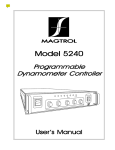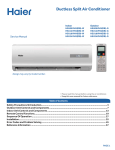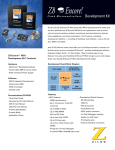Download USER MANUAL - e-Gizmo Mechatronix Central
Transcript
USER MANUAL
UP IRC SlimBoard set
UP IRC SlimBoard set
University of the Philippines - Diliman
INTRODUCTION
A microcontroller unit (MCU) or most commonly called as a microcontroller is a computer implemented on
a single chip. Just like desktop and mainframe computers, the microcontroller also contains the basic components
that these computers have such as the Central Processing Unit (CPU), Random Access Memory (RAM) and
input/output devices (I/O) devices. However, microcontrollers are special purpose computers whose dedication is
to perform one task at a time, unlike a desktop computer that can do several tasks simultaneously.
Microcontrollers are low-powered devices that are usually used by embedding them into other products or
devices so that they can control the actions that these devices will do. It takes input from the device that it controls
and also sends signals to it to manipulate its actions. A microcontroller needs to be programmed before it can be
used to control devices.
Unlike a microprocessor that generally requires external components to implement a program, a
microcontroller already incorporates all the resources needed internally in a single chip. Microcontrollers are
usually designed to perform a small set of specific functions, whereas microprocessors tend to be designed to
perform a wider set of general purpose functions that are performed in a personal computer (PC).
The UP IRC SlimBoard is a module that utilizes the on-chip peripherals of the Z8F6421 Flash
Microcontroller, like the eight-channel Analog-to-Digital Converter (ADC) and the Universal Asynchronous
Receiver/Transmitter (better known as UART). The board is powered using a 9VDC adapter and uses pin headers to
access the input/output pins of Z8F6421 44 pin PLCC.
The Z8F6421 Flash Microcontroller is a Flash-capable microcontroller based on Zilog's advanced eZ8-8bit
microprocessor core. The Flash in-circuit programming capability allows for faster development time and program
changes in the field. Its rich peripheral set makes it suitable for a variety of applications including motor control,
security systems, home appliances, personal electronic devices and sensors.
This User Manual contains guides in using the hardware and software materials needed in using the kit. It
also includes instructions on how to install and use the ZDS II as a compiler and assembler plus examples and
sample exercises to help the user understand the applications of the product.
UP IRC SlimBoard set
University of the Philippines - Diliman 1
TABLE OF CONTENTS
Introduction.................................................................................................................................................... 1
Table of Contents............................................................................................................................................ 2
Product Overview
Product Features .............................................................................................................................. 3
Product Additional Specifications..................................................................................................... 3
UP IRC SlimBoard Lay-Out................................................................................................................. 4
Package Contents.............................................................................................................................. 4
Before Getting Started
Hardware Set-up .............................................................................................................................. 5
ZiLOG ZDS II - Z8Encore! 4.10.1 and Hyperterminal ........................................................................ 5
The C Language Structure .............................................................................................................................. 6
Getting Started
Using the ZiLOG ZDS II - Z8Encore! 4.10.1 ....................................................................................... 7
Sample LED Blinker Code ............................................................................................................... 18
An example of an application of Z8 Encore!
Ham Radio Repeater Locator
UP IRC SlimBoard set
University of the Philippines - Diliman 2
PRODUCT OVERVIEW
A. Product Features
The UP IRC SlimBoard set is designed to give electronic enthusiast an initial application material in their
prototyping and laboratory needs. The board supports the Z8F6421 in the 44-pin package. These controllers
have a program memory built on Flash technology which provides fast erasing and reprogramming, thus
allowing a quick debugging or error checking. The UP IRC SlimBoard set has the following main features:
eZ8 CPU 20MHz Operation
8-channel, 10-bit analog-to-digital converter
3-channel Direct Memory Access
64KB Flash memory with in-circuit programming capability
4KB register RAM
Serial Communication protocols
Two full-duplex 9-bit UARTs
24 interrupts with programmable priority
Three 16-bit timers with capture, compare and PWM capability
Single-pin On-Chip Debugger
Two IrDA-compliant infrared encoder/decoders integrated
Watch-Dog Timer with internal RC oscillator
Up to 31 General Purpose Input/Output pins
Voltage Brown-out Protection
Power-On Reset
0 to +70 degree Celsius standard temperature operating ranges
B. Product Additional Specifications
The UP IRC SlimBoard set has the following specifications:
8 channel analog input (direct buffered) with GND header pair
Adjustable external voltage reference
PCB mounted DB9 RS-232 interface
LED Power indicator
+9V Unregulated Supply (from adaptor)
+5V and +3.3V on-board regulation
Remaining digital lines on headers
UP IRC SlimBoard set
University of the Philippines - Diliman 3
C. UP IRC SlimBoard Layout
Z8F6421
Port A
MAX232CPE
Reset Switch
DC Power Jack
Serial port (RS 232)
LED power indicator
L7805CV
UART/Debug switch
LM1117
Port B
Potentiometer (POT)
Figure 1. UP IRC SlimBoard Set
D. Package Contents
The UP IRC SlimBoard set should contain the following materials:
a. UP IRC SlimBoard with Z8F6421 Microcontroller
b. CD containing software tools, sample program codes and support documentations
c. Serial Cable (RS-232 data cable)
d. AC-DC power supply adapter
e. Portable case
UP IRC SlimBoard set
University of the Philippines - Diliman 4
BEFORE GETTING STARTED
A. Hardware Setup
Serial Port
Serial Cable
220 AC Outlet
UP IRC SlimBoard
AC-DC power supply adapter
Figure3. UP IRC SlimBoard Set Hardware Setup
B. ZiLOG ZDS II - Z8Encore! 4.10.1 and Hyperterminal
A compiler is a software that is used to translate high-level languages (languages that are understood by
humans) into machine-level languages. A program starts from a source code and is then translated by the
compiler into a series of bits that tells the microcontroller what to do.
The ZiLOG ZDS II – Z8Encore! is a software program that can be used to easily compile and download the
code into the SlimBoard. The HyperTerminal serves as the communication tool between the SlimBoard and PC.
UP IRC SlimBoard set
University of the Philippines - Diliman 5
THE C LANGUAGE STRUCTURE
C Language belongs to medium level of computer language which is the combination of high level
language (human language) and low level language (machine language). In able to have a good program in C
language, the algorithm or flow chart must establish first. This section features the structure of a C program.
Every program consists of one or more functions, one of which is called the main. This function is written
as:
main() {
expressions;
}
Additional function definition may precede or follow the main function. Each function must contain the
following:
A function heading, which must include the function name, followed by an optional list of arguments
enclosed by parentheses.
A list of argument declarations, if arguments are included in the heading.
A compound statement, which comprises the remainder of the function.
Each compound statement is enclosed within a pair of braces, {statements}. The braces contain
combinations of elementary or compound statements called expressions. Each expression must end with a
semicolon (;). Comments or remarks may appear anywhere in the program as long as they are placed within
delimiters (/*comments*/) or double slash (//) in most microcontrollers. Comments play an important
part in the documentation of the program.
Since all C programs must have their variables declared prior to using them, frequently used variables and
references to predeclared C functions, may be used within a program can be contained within a separate header
file. Header files can then declared prior to using them, frequently used variables and references to predeclared
C functions, may be used within a program and be contained within a separate header file. Header files can
then be combined into a program by calling them with an #include statement. All header files have the file
extension of .h. The syntax of the header file is:
#include <header file> /*library file access*/
The program that you have written in C is called a source code. However, this cannot be executed on any
physical hardware like the microcontroller in this form. It must be processed by the C Compiler and convert it
into a HEX file. Shown below is the general structure of a C language.
#include <header file>
#define statements
//declare header files to be used
//declare the constants to be used
typedef and struct statements; //declare own type names and own
//instructions
global variables;
//declare global variables
UP IRC SlimBoard set
University of the Philippines - Diliman 6
return_type user_function() {
local variables;
statements;
return;
}
//declare function name, return type
//and parameters
//return value to the calling function
return_type main() {
//declare the return type and command line arguments
local variables;
code statements or expressions;
}
GETTING STARTED
This sample program given below turns the LEDs on and off. This is why the program is called a “blinker”,
which is one of the most common programs used to learn the basics of microcontroller programming. This program
also prints “Hello World” in the HyperTerminal via the UART.
The implementation of this exercise is shown in the example below:
A. Using the ZiLOG ZDS II – Z8 Encore! 4.10.1
1. Creating a new project
a) Open ZDS II.
UP IRC SlimBoard set
University of the Philippines - Diliman 7
b) Click File → New Project from the main menu.
c) Enter Project Name and location.
d) Match this data:
• Since ZDS II can support many types of Z8 microcontrollers, we need to specify the
specific kind of microcontroller.
i) Project type: Standard
ii) CPU Family: Z8Encore_64K_series
iii) CPU: Z8F6421
iv) Build Type: Executable
UP IRC SlimBoard set
University of the Philippines - Diliman 8
e) Click Finish button.
f) Click Project → Settings from the main menu.
UP IRC SlimBoard set
University of the Philippines - Diliman 9
g) Click Debugger tab.
h) In debug tool, select SerialSmartCable from the dropdown menu.
i) Click Setup button.
UP IRC SlimBoard set
University of the Philippines - Diliman 10
j) Match this data:
• The setting for baudrate is the recommended setting for this particular microcontroller. In
addition, there is a chance that there is a computer with more than one COM port.
Therefore, we need to specify the correct COM port.
i) Baudrate: 57600
ii) COM port: select correct COM port
k) Click OK to return to default screen.
UP IRC SlimBoard set
University of the Philippines - Diliman 11
2. Adding a file to a project
● Projects are different from files. Projects can have many files that contain the
codes for the program. This can be header files or the main program, etc.
a) When creating new file
i) Click File -> New File from the main menu.
ii) Insert code
● The code can be found at page 18. You can skip this step just
to familiarize and test on how to proceed next.
● Here is how it should look like:
UP IRC SlimBoard set
University of the Philippines - Diliman 12
iii) Save file with *.c extension.
iv) Right click on the editor window, select Add files to Project.
v) To check, expand standard project files folder to see the file
b) When loading existing file to project
i) Right click standard project files folder , select Add File to project
ii) Select the file you want
iii) Double click file to show on the editor
3. Downloading code
a) Click Rebuild All on the toolbar
● In this part, the program will compile your code. If there is any errors on your
program, ZDS will not compile and displays the errors on the lower part of
the window
b) Click Download Code on the toolbar
● You will know that the download is successful because it will displayed on the
debug tab, seen on the lower part of the window
c) When finished downloading, click stop debugging (shift+f5)
UP IRC SlimBoard set
University of the Philippines - Diliman 13
d) Push the Reset switch on the SlimBoard
● Look for the Reset button near the DC power jack. The display LEDs should
“blink”.
Reset
4. Using UART
a) Check push button (must be “low” for UART)
● Look for the toggle button near the serial port on the SlimBoard. This is the
selector for the DEBUG/UART function of the serial port.
UART/Debug
switch
b) Open HyperTerminal
UP IRC SlimBoard set
University of the Philippines - Diliman 14
c) Enter name of new connection and click OK.
d) Select correct Com Port on the Connect Using field.
e) Click OK
UP IRC SlimBoard set
University of the Philippines - Diliman 15
f) Match this data:
i) Bits per second: 57600
ii) Databits: 8
iii) Parity: none
iv) Stop bits: 1
v) Flow control: none
g) Click OK
● After clicking ok, the hyperterminal will automatically place a call. But if it doesn’t, click the Call
button on the toolbar to place a connection.
h) Reset SlimBoard
UP IRC SlimBoard set
University of the Philippines - Diliman 16
i) Check the Hyperterminal console, “Hello World” should appear once:
● When you are done testing, you can end the call by clicking the Disconnect
button on the toolbar.
UP IRC SlimBoard set
University of the Philippines - Diliman 17
B. Sample LED Blinker Code
/* This is includes the three header files namely: ez8.h,stdio.h,sio.h. The
header files contain the necessary functions that is used in microcontrollers.
*/
#include <ez8.h>
#include <stdio.h>
#include <sio.h>
/*Defines that all instances of GPIO_PORT be replaced by 0x03 */
#define GPIO_PORT 0x03
/*This is called a function. This creates a function named initGPIO */
void initGPIO(void) {
//
//
PDDD &= ~GPIO_PORT;
PDAF &= ~GPIO_PORT;
PDOC |= GPIO_PORT;
PDHDE |= GPIO_PORT;
//
//
//
//
data direction: output
alternate function: off
output control: open-drain (optional)
high drive enable: high drive
//(optional)
}
/* This creates a function named delay. Essentialy, this function counts from 0
to FF many times. This causes some processing time delay. */
void delay(void)
{
unsigned char i,j;
for(i = 0; i < 0xFF; i++)
for(j = 0; j < 0xFF; j++);
}
`
/* This is the main function. This is the function that is executed first. */
int main(void)
{
init_uart(_UART1, _DEFFREQ, _DEFBAUD); // Initializes UART
initGPIO(); // Calls the function that we created earlier
printf("Hello World\n");
/*printf is a function that displays what is
inside its parameters. You could try to replace
“Hello World” with something else */
while(1)
// essentially a never-ending loop
{
PDOUT ^= GPIO_PORT; /* Compares the current value of PDOUT with the
value of GPIO_PORT using XOR. */
delay();
/* Calls the function delay. This causes the LED to
blink */
}
}
UP IRC SlimBoard set
University of the Philippines - Diliman 18
ADDITIONAL INFORMATION
For more advanced projects, you could buy the IRC Microcontroller Training kit. This package contains the
following components:
a. UP IRC SlimBoard with Z8F6421 chip
b. DC Adapter
c. Installation and Documentation CD
d. Serial Cable
e. SlimBoard Workbook
f. Protoboard/Breadboard
g. Pre-stripped wires and Alligator Clips
h. 9-V battery
i. Colorimeter Module
j. Temperature Signal Conditioning Module
k. Servomotor
l. LED Set (R, G, B or Y)
m. Piezo-electric Buzzer
n. Resistors, LDR, Potentiometer
Temperature Signal Conditioning Module
UP IRC SlimBoard set
Colorimeter Module
University of the Philippines - Diliman 19
UP IRC Microcontroller Training Kit
For inquiries, you could call the Instrumentations, Robotics, and Control Laboratory at:
Tel. no: (+632)981-8500 loc. 3360
Fax no: (+632)925-2957
UP IRC SlimBoard set
University of the Philippines - Diliman 20
INSTRUMENTATION, ROBOTICS, AND CONTROL LABORATORY
Room 311, Department of Electrical and Electronics Engineering
DEEE Building, Velasquez Street, U.P. Campus, Diliman, Quezon City
UP IRC SlimBoard set
University of the Philippines - Diliman 21

































